Most people in the modern, Western democratic world take freedom of speech for granted. They wake up each day automatically assuming that it is their right to say, think and publish whatever they feel, and their assumption is supported by a leadership, media and press institution who work hard to protect this. In many other communities around the world however, freedom of speech is not an inalienable right. The people of those nations have their thoughts, true feelings and opinions censored and suppressed, and they are told what and how to think.
This suppression is something that many governments vehemently disagree with, to the point some feel compelled to fund alternative media agencies, and sources of news and information. For example, the BBC (funded by the British public) as well as Radio Free Asia (funded by the American government) broadcast in some of the world’s most war-stricken, disaster-ridden locations where freedom of speech is severely curtailed.
But this suppression however, is not existent in India and other places around the world where the Tibetan people may be found. In India, the world’s largest democracy, freedom of speech is guaranteed; in the USA, Switzerland, Australia, Canada and Western Europe, the Tibetans enjoy the freedom of speech afforded to all citizens and residents of those nations. Having witnessed firsthand how governments protect their citizens’ rights, it is therefore all the more incredible that the Tibetan leadership continues to suppress the freedom of speech of their people.
Since they entered into exile, the Tibetan leadership has accumulated an incredible number of instances whereby they have stymied their people’s freedom of speech. Below are just a handful of significant examples from recent history that are still fresh in our memories, and will help observers realize the true nature of the Tibetan leadership. That is to say, it is not a leadership that was established to preserve the rights and livelihood of their people, or to compel them towards social and economic advancement. It is a leadership that was established to protect the rights of a few, and to ensure that the system of privilege carried out in pre-1959 Tibet would continue on in exile.
Treatment of Lukar Jam
During the 2016 Sikyong elections, Lukar Jam was running as a popular opponent against the incumbent Prime Minister Lobsang Sangay and former Speaker of Parliament Penpa Tsering.
Lukar Jam was especially effective in garnering support among the younger Tibetans. Open-minded and exposed to new ideas, the youth had become jaded by the ruling establishment’s ineffective leadership. Thus they rallied around Lukar Jam’s broad-thinking manifesto which included provisions for a less biased treatment of Dorje Shugden practitioners.
It was this precise manifesto that was deemed traitorous and somehow anti-Dalai Lama, and the Tibetan leadership were swift in their retribution. Not only did they fail to stem the rumor he is anti-Dalai Lama, but they also spoke about it too and promoted the idea. And after the first round of voting had already taken place, the Election Commission was harangued into changing the rules, effectively disqualifying Lukar Jam from the race.

The result of the Tibetan leadership’s sustained campaign to harass Lukar Jam culminated in a violent attack on his car in March 2017.
Lukar Jam’s ideas seemingly challenged the status quo of the establishment, and the Tibetan leadership acted quickly to shut down his platform to speak by removing him as a Sikyong candidate. Since then, the violence against him has not ended. The ‘Lukar Jam is anti-Dalai Lama’ accusation has endured, to the point he and his family were recently the victims of a violent attack on their car.
Interestingly, Lukar Jam was not the only victim of this election. During the campaign, Lobsang Sangay and his only other opponent Penpa Tsering were at extreme odds. They engaged in a level of mud-slinging so previously unheard of, that it even attracted the attention of the New York Times as well as earned them the displeasure of His Holiness the Dalai Lama and Nechung. After Lobsang Sangay won however, Penpa Tsering was conveniently reassigned to the United States as the Dalai Lama’s representative (donjo) and stationed there.
Encouraged by opportunities in America to monopolize the visa-for-money schemes, Penpa Tsering became uncharacteristically quiet after his installation as the donjo. Financial incentives are another method exploited by the Tibetan leadership to suppress freedom of speech. In short, they are not above buying people’s silence.
Removal of open letter from Tibet Sun
Another significant instance of the Tibetan leadership shutting down freedom of speech took place after the passing of the late Professor Elliot Sperling. A renowned Tibetologist and supporter of the so-called Tibetan cause, Professor Sperling had many friends among the Tibetan community, most notably Lukar Jam. Upon his friend’s passing, Lukar Jam penned a poem in his memory. The result however, was less than commemorative.
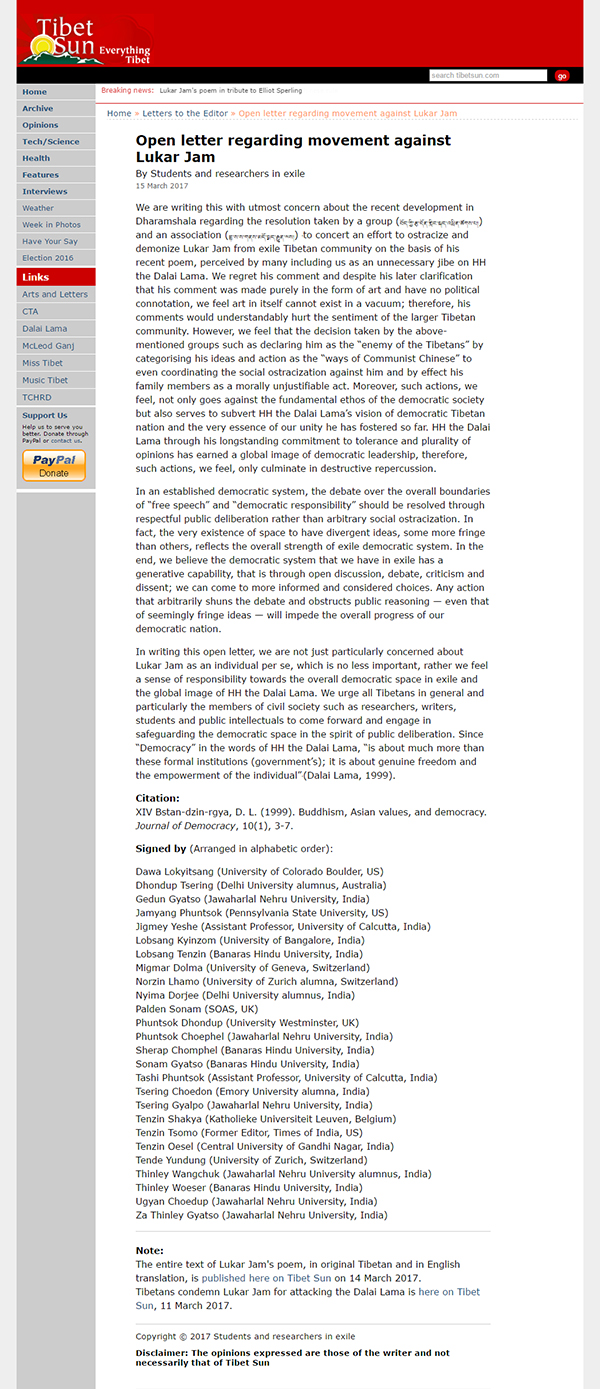
The original letter before it was removed. Click to enlarge. Extracted from https://www.tibetsun.com/letters-to-the-editor/2017/03/15/open-letter-regarding-movement-against-lukar-jam-by-tibetan-studentsresearchers-in-exile
In his poem, Lukar Jam wished that his friend had lived to 113 years. This was taken by some to be an anti-Dalai Lama statement. Because the Dalai Lama has been saying he will live to 113 years of age, they felt Lukar Jam’s statement meant he wished Professor Sperling had lived to 113 years, instead of the Dalai Lama.
Nowhere did Lukar Jam ever make such a statement and certainly, the ability for someone to live to 113 years is not exclusive to the Dalai Lama. Furthermore, to wish for one’s friends to have a long life is nothing wrong. Yet, Lukar Jam’s critics did not see it this way.
There was an uproar in the Tibetan community after Lukar Jam was accused of making anti-Dalai Lama statements. The protestations came from both the pro-Lukar Jam and anti-Lukar Jam camps. From the anti-Lukar Jam quarters, the Tibetan leadership (led by Lobsang Sangay) saw it fit to use their March 10 memorial celebrations to condemn Lukar Jam. March 10 is one of the most significant days in the Tibetan calendar, commemorating the March 10 uprising in Lhasa back in 1959. On this significant occasion, Lobsang Sangay chose to use his speech to target Lukar Jam.
From the pro-Lukar Jam camp, a significant protest came in the form of a group of 26 Tibetan researchers and students living in exile. They penned an open letter denouncing those who were making false accusations against Lukar Jam. In their fair and broad-minded letter, they explained that it is characteristic of a democratic society to allow people to express different views. They also expressed that suppressing freedom of speech will “impede the overall progress of [a] democratic nation.” Their letter was then posted on Tibet Sun, only to be mysteriously removed a few days later.
This is not the first time articles that are critical of the leadership have been censored by Dharamsala, who have even shut down entire newspapers in the past for daring to present a view that differs from theirs. If pressuring a newspaper to close down is all in a day’s work for them, getting rid of an article from the Internet is child’s play in comparison.
Shut down of Mangtso newspaper
In 1996, renowned essayist Jamyang Norbu was living in Dharamsala where the Tibetan leadership is headquartered. Among his many activities to support the so-called Tibetan cause, Jamyang Norbu was editing the Mangtso newspaper together with a group of friends. Mangtso was known to publish news and present a viewpoint that differed from the establishment’s. Its aim was to widen the Tibetan people’s access to information and different points of view.
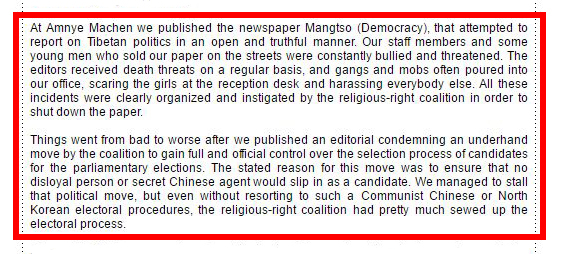
An excerpt from the Phayul article regarding the Mangtso newspaper’s closure. Click on the image to read the full article.
Though a brave sentiment, their motivation was ultimately their downfall. No freedom-promoting publication can exist under the tyranny of a leadership with the unsavory habit of censoring their critics. After Mangtso was accused of publishing anti-Dalai Lama and anti-independence statements, its editors and journalists began to receive death threats and threats of violence against them.
These threats grew so violent that eventually, Jamyang Norbu and his friends had no choice but to draw the shutters on the newspaper. The Tibetan leadership had quite literally shut down freedom of speech.
The people’s treatment of Jamyang Norbu
One need only look at some of the online comments made about Jamyang Norbu to imagine the amount of hate against him, all because he sometimes disagrees with the Tibetan leadership. In fact, when a picture of Jamyang Norbu with Dechen Tulku (a prominent Shugden practitioner) was circulated on social media, supporters of the Tibetan leadership were quick to condemn him. They touted the picture as evidence of Jamyang Norbu’s anti-Dalai Lama stance.
Jamyang Norbu issued a strong defence of his actions, saying that simply appearing in pictures with people does not mean you support their views.
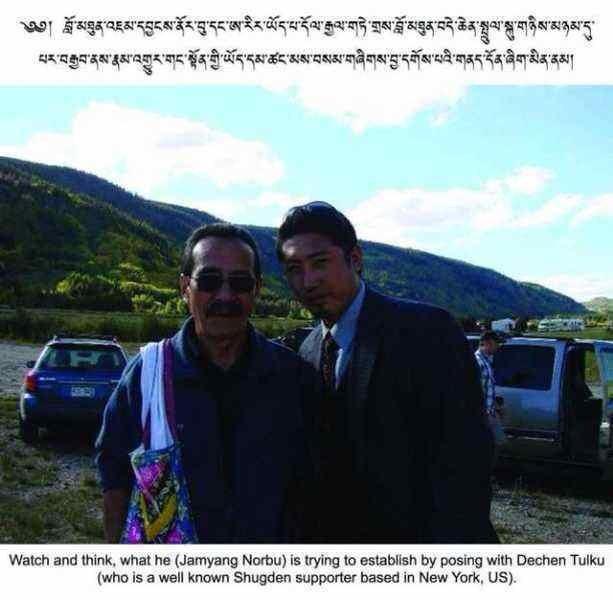
Look at the image caption and what the author was trying to imply by Jamyang Norbu appearing in this image with Dechen Tulku, a prominent Shugden practitioner. Jamyang Norbu was targeted and abused for this image; one can only imagine how much abuse he has suffered throughout the years for his published works.
But if merely appearing in a photo of someone could earn him such swift condemnation, imagine the amount of abuse he has had to put up with over the years for running Mangtso, as well as all the other articles he has written which were critical of the Tibetan leadership.
Today, Jamyang Norbu lives in the United States where he has the freedom of speech to write and publish whatever he wants on his blog. As a writer and journalist, there is no doubt he would relish the opportunity in the US to freely speak his mind but as a Tibetan, one can safely assume he would rather be able to exercise this freedom in Dharamsala among the rest of his compatriots. To do so however, with the current Tibetan leadership in place, would never be safe given the leadership’s penchant for shutting down freedom of speech.
Hit lists to intimidate people into silence
We have seen how the Tibetan leadership will buy their rivals’ silence (Penpa Tsering), orchestrate their marginalization (Lukar Jam) and literally shut down proponents of freedom of speech (Mangtso newspaper). There should be little surprise therefore, that they would resort to using violence.
In 2014, Dorje Shugden practitioners gathered at various locations across the United States and Europe to protest against the Dorje Shugden ban. Wherever His Holiness the Dalai Lama went to give a talk, the protestors would be there to speak up for their religious freedoms. The reception that the Tibetan leadership gave them was, suffice to say, less than welcoming.
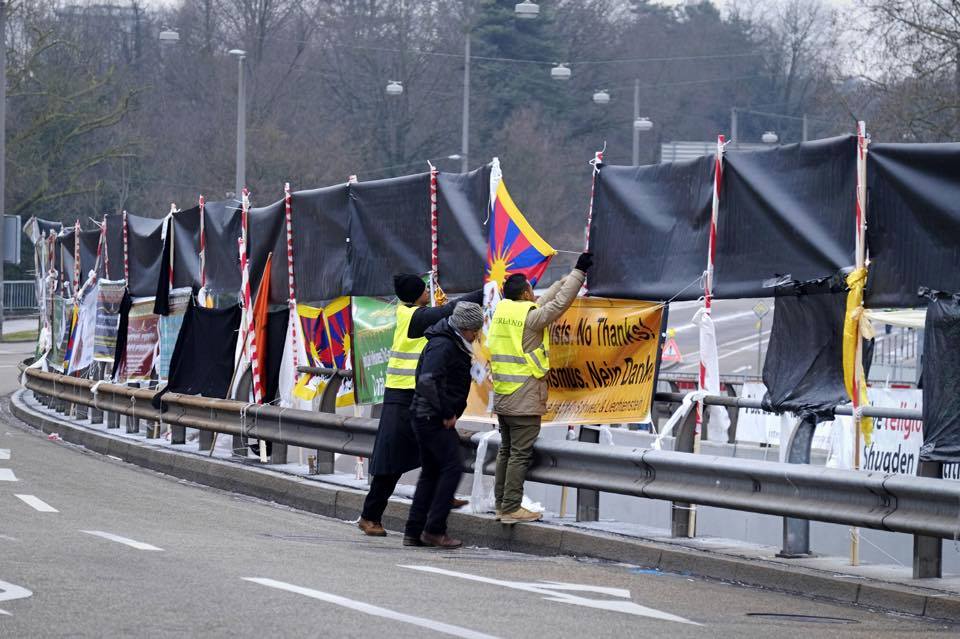
The Tibetan leadership’s version of freedom of speech. This is how the Tibetan leadership dealt with Shugden protesters in Europe. They erected large black banners so the protesters and their signs would be blocked from the view of people attending the Dalai Lama’s talks.
In some locations, the Tibetan leadership erected large banners to block the protestors from being seen by the media or by those attending the Dalai Lama’s talks. In other locations, the leadership’s supporters were photographed showing rude and vulgar signs to the Shugden protestors. The worst however, was yet to come.
A few weeks after their protests, the Tibetan leadership issued two hit lists with the faces, names and details of some Tibetans who protested. In the case of one lady, they even listed her home address. The intent was clearly to let people know where they could direct their violent displeasure towards. On these lists were only Tibetans who protested against the ban; they did not include any Western faces even though it was the UK-based International Shugden Community (ISC) who had organized the protests.
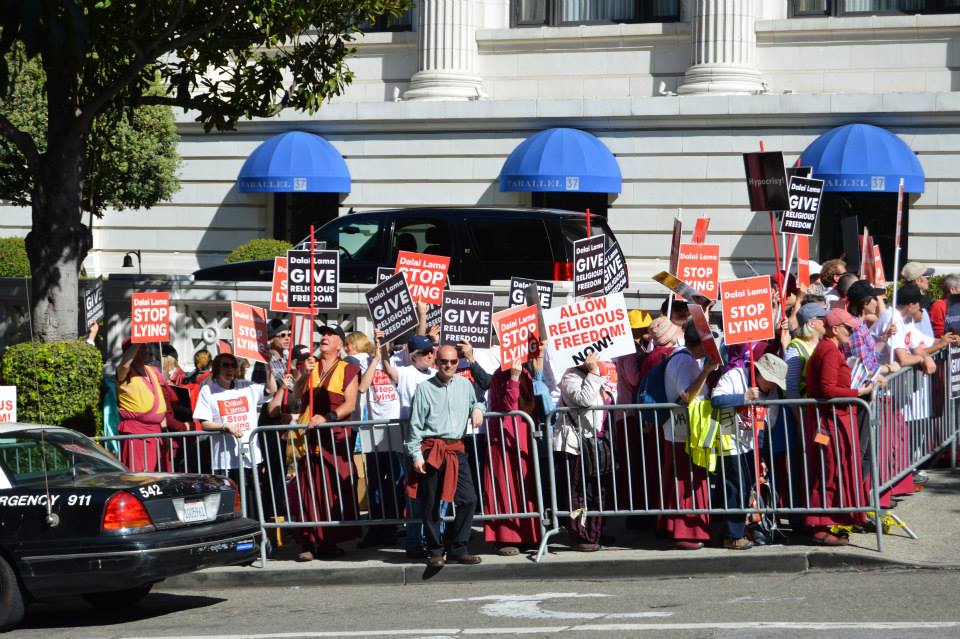
Despite the fact the majority of the protesters were Caucasian and the organizers came from the UK-based International Shugden Community (ISC), not a single ISC member was targeted in the Tibetan leadership’s hit list. They only targeted and identified their own people, as these Westerners are protected by governments who fund the Tibetan leadership.
The message is clear – the Tibetan leadership has zero tolerance for any dissent or differing views from their own people. If these views are shared by Westerners however, the leadership will turn a blind eye. After all, featuring Westerners on these types of hit lists is not good public relations and these Westerners are citizens of nations with governments who direct financial aid to the Tibetan leadership. These governments would not be very happy if their people appeared on hit lists simply for speaking their mind. But to target and attack Tibetan protestors is okay, because it is acceptable to shut down the freedom of speech of their own people.
Alternative hit list of rangzen people
It appears that in fact, no one is immune from the Tibetan leadership’s love of hit lists. In 2015, after the March 10 rangzen (independence) versus umaylam (Middle Way Approach) clashes in New York, the following hit list appeared online in the days after the fight.
The issue started because a number of rangzen supporters had turned up at the annual March 10 commemorative rallies. Their call was for a fully free and independent Tibet, contrary to the Dalai Lama’s umaylam or Middle Way Approach for meaningful autonomy. Their call was therefore interpreted as being anti-Tibet and anti-Dalai Lama, an accusation which hurt a great number of rangzen supporters who are very devoted to Tibet and the Dalai Lama.
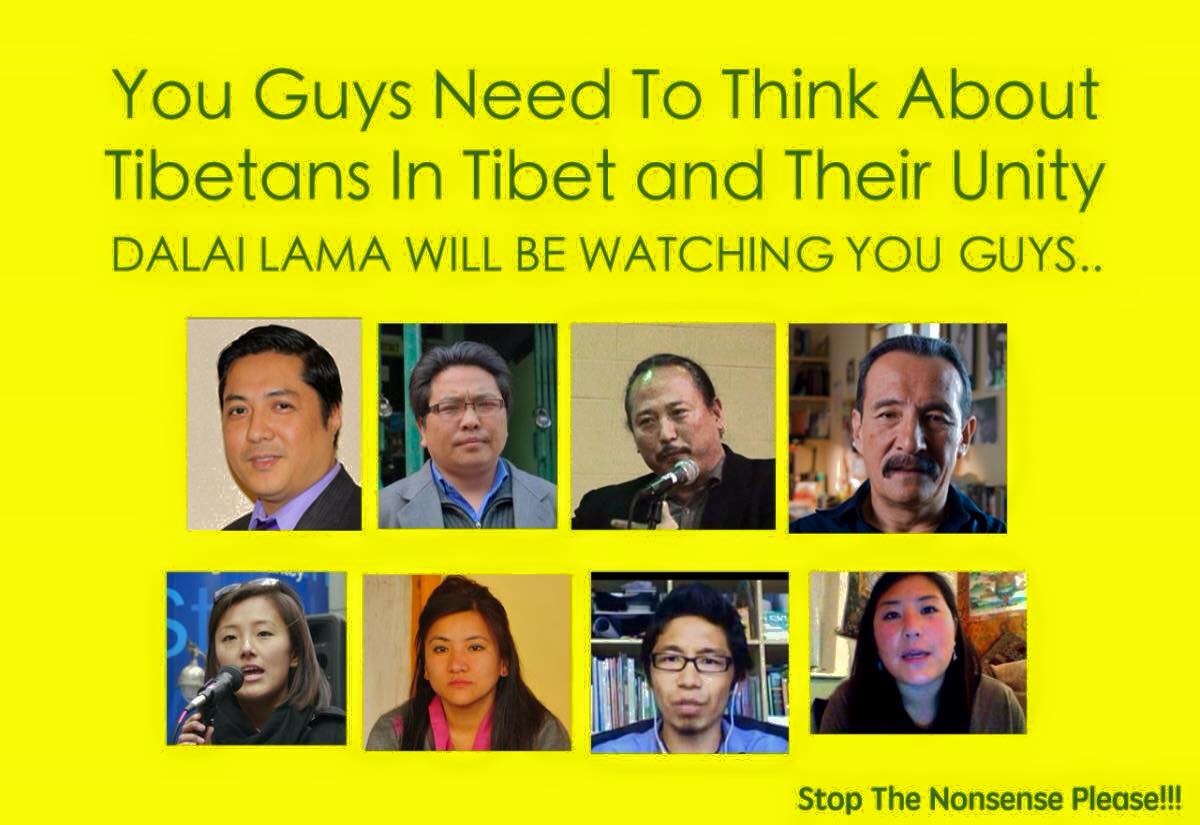
Tibetan community leaders who support rangzen (full independence) were immediately targeted in this hit list released a few days after the clashes with supporters of the Dalai Lama’s umaylam (Middle Way Approach) stance. The headline is the very ominous “Dalai Lama will be watching you guys”.
And as a result of their perceived audacity to withhold support for the Dalai Lama’s choice, the rangzen protestors also had the distinction of being included in the next hit list. This list identified the specific community leaders as being pro-rangzen and implied they are anti-Dalai Lama. The hit list was then widely circulated among the Tibetan community and social media. Throughout this incident, the Tibetan leadership remained quiet. This was a clear message from the Tibetan leadership – they will only support umaylam and nothing else, and everyone else is left to fend for themselves.
The Dalai Lama’s name was even pulled into this list, in the form of the veiled threat “Dalai Lama will be watching you guys”. It was a warning to them to be careful as there are consequences for going against the Dalai Lama. This is the same situation faced by Dorje Shugden practitioners who are considered anti-Dalai Lama, and have had to suffer the violent consequences of being perceived as such over the last 20 years. On any topic, whether it is Shugden or the so-called Tibetan cause, there is no room for views that differ from the Tibetan leadership’s and it will always be a very dangerous thing to be perceived as anti-Tibetan leadership.
Forcing people to move away
In fact, Dorje Shugden practitioners have never been able to speak their mind or practice freely since the Tibetan leadership’s ban of the practice was imposed in 1996. Over and over again, Dorje Shugden practitioners have been forced to move from their homes and leave behind everything they own. The fact someone’s address can be included on a hit list only reflects one thing – the Tibetan leadership want to direct a mob against that person, to harass them out of their homes.
This is a tactic that they are certainly very familiar with; in 1997, the Tibetan leadership incited a mob to riot against Dokhang Khangtsen of Gaden Shartse Monastery. A khangtsen is a fraternity house within a monastery, where monks from the same region in Tibet will live, study and practice together. This mob action eventually drove Dokhang Khangtsen to split from Gaden Shartse Monastery, and to form an entirely new monastery altogether, known as Shar Gaden Monastery to preserve and protect their Dorje Shugden practice.
During the riot, the Indian police had to be called in to protect the peaceful monks from the vicious mob.
For example, His Holiness Kyabje Yongyal Rinpoche was forced from his home in the middle of the night after his ‘students’ threw rocks at his windows. With the threat of violence in Sera Mey increasing against him, Yongyal Rinpoche had no choice but to leave. He subsequently left for Australia where he was again harassed by the Tibetan community there. The community supported the Dalai Lama and Tibetan leadership in their Dorje Shugden ban, and they created visa-related issues for him.
Kyabje Yongyal Rinpoche was subsequently forced to leave Australia and seek refuge in Taiwan where, yet again, the Tibetan community continued to harass him for refusing to give up his Dorje Shugden practice. This elderly lama was unable to live in peace until he arrived in America, where he can finally live a quiet and private existence in California. A true shame for such a grand and scholarly master with much to share and contribute to the rest of the community.
And Kyabje Yongyal Rinpoche is not the only elderly lama who has been targeted and attacked. In 2013, the 84 year old Gen Chonze was viciously stabbed in the early hours of the morning by five masked assailants. The attack came following a speech given by the Tibetan leadership.
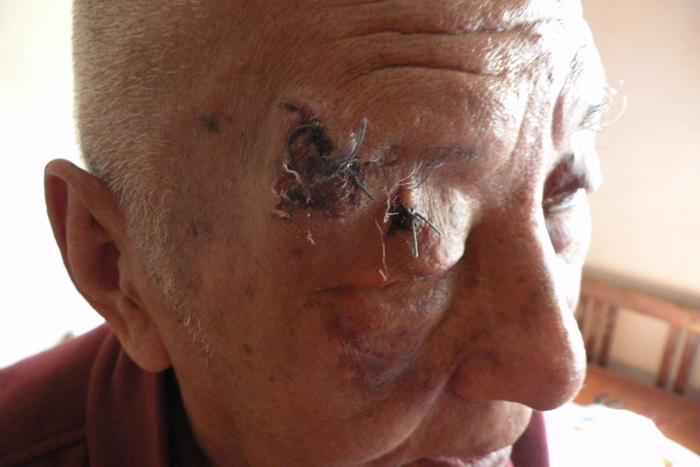
In 2013, 84 year old Gen Chonze was viciously stabbed multiple times by masked assailants. The attack came immediately after a speech by the Tibetan leadership against the Dorje Shugden practice.
Who would have spurred the people to attack these elderly lamas, if it was not the Tibetan leadership? Would the Tibetan leadership really have us believe that Tibetans all over the world are subscribed to the same brand of mindless violence targeted against elderly monks who want to exercise their religious freedom? We do not think the Tibetan public would do this; in fact, we have more faith in the Tibetan public than their leadership does, and believe the Tibetan public have the capacity to think. They would never have committed these atrocities against the elderly unless they were incited by their leadership.
The purpose of forcing someone from their home repeatedly is designed to remove them from their bases of support where their views may be able to gain strength. By forcing Kyabje Yongyal Rinpoche, for example, to move over and over again, they prevented him from influencing the local Tibetans in the area. He was thus unable to show them, through reasoning and logic, why the Dorje Shugden ban is illogical.
The Tibetan leadership however, suffers from severe tunnel vision because thanks to their inefficacy, they have become reliant on handouts. Over the last 60 years, they have become increasingly beholden to the generosity of their benefactors; when their benefactors say “Jump”, the leadership can only reply “How high?”. What they do not realize is that the world has changed and news of their crimes against the Tibetan people cannot be stopped.
While they might be able to censor what news reaches their own people, they cannot censor what reaches the far corners of the globe. For the sake of continuing to receive financial contributors from generous donors, it would behoove them to stop thinking about censoring Tibetans and realize that the whole world is watching through the Internet. For every Tibetan’s freedom of speech that they censor, that is one less supporter (and source of income) they will have from the rest of the world.
Name-calling and black-listing those who disagree
Anyone who dares to show any form of disagreement with the Tibetan leadership is often subjected to a litany of names, abuses and insults. These insults range anywhere from “CCP traitor” and “Chinese dog”, to extreme vulgarities that are not suitable for print.
In all instances, the abuse is personal, irrelevant to the topic and designed to shame, defame, blacklist and stain the reputation of the victim. And in certain special cases, the abuse is designed to annihilate the credibility of the victim.
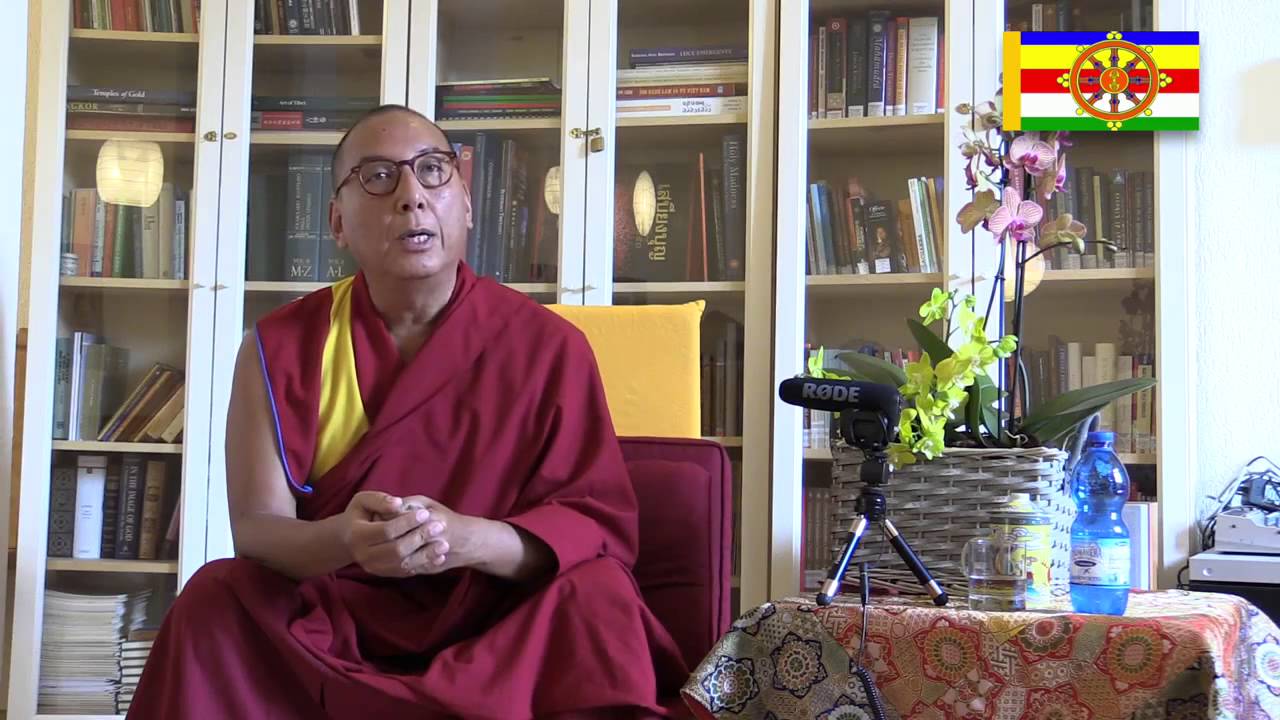
An eloquent speaker and accomplished scholar, His Eminence Kundeling Rinpoche is very much a qualified teacher. Unfortunately, the Tibetan community have not been able to connect with him thanks to their leadership’s sustained campaign of defamation against this lama.
Take His Eminence Kundeling Rinpoche for example. In early 2008, he very bravely brought a legal suit against His Holiness the Dalai Lama, stating that the Dalai Lama had violated human rights by enforcing the Dorje Shugden ban. As a result of this case, Kundeling Rinpoche has since been called “Nga Lama”, an epithet implying he is a self-recognized tulku or reincarnated lama. This of course, is not true and Kundeling Rinpoche was recognized by the proper authorities but by calling him “Nga Lama”, the Tibetan leadership and their supporters are labelling him a charlatan whose words have no credibility.
Another major victim of Dharamsala’s sustained campaign to insult and defame is none other than His Eminence Gangchen Rinpoche. Gangchen Rinpoche is a renowned healer and lineage holder of the NgalSo line of tantric self-healing teachings. In the late 1990s, Gangchen Rinpoche filmed a self-healing ritual involving the use of candles and light which the Tibetan leadership then seized and purposefully misinterpreted.
At the time, the Tibetan leadership had an entire section of their website dedicated to defaming Gangchen Rinpoche. On this website, they extracted segments of Gangchen Rinpoche’s healing video and uploaded them without any accompanying explanation. The extracts served to mock Gangchen Rinpoche as a teacher of strange practices to unsuspecting victims. That the Tibetan leadership would go so far as to mock an entire tantric lineage in order to accomplish their secular goals, is not a surprise to anyone who has knowledge of how they deal with dissent.
Over the years, the Tibetan leadership have also systematically accused Gangchen Rinpoche of being a Chinese-paid spy and of being a traitor to the so-called Tibetan cause. Instead of promoting his other works and bolstering his ability to benefit sentient beings, this is how the Tibetan leadership has treated a lama simply because he refused to toe their party line of giving up Dorje Shugden practice. Yes, to try and shut down his freedom of speech, the Tibetan leadership have been at the forefront of abusing this lama (and many others) over the last two decades.
Jonangpas forced to go on hunger strike to get parliamentary representation
Within the Tibetan Parliament-in-Exile (TPiE), all Buddhist traditions have their representatives elected to the Parliament to ensure that their interests are represented. This means that within the TPiE, the Gelugs, Sakyas, Nyingmas and Kagyus have their representatives. The Bonpos are also represented, with two elected members taking their seats.
A notable omission to this system however, are the Jonangpas who were recognized as a Buddhist sect in 2011. Their recognition came after centuries of oppression which began during the time of the 5th Dalai Lama, when the Jonangpas were forcibly converted to the Gelug school of Buddhism.
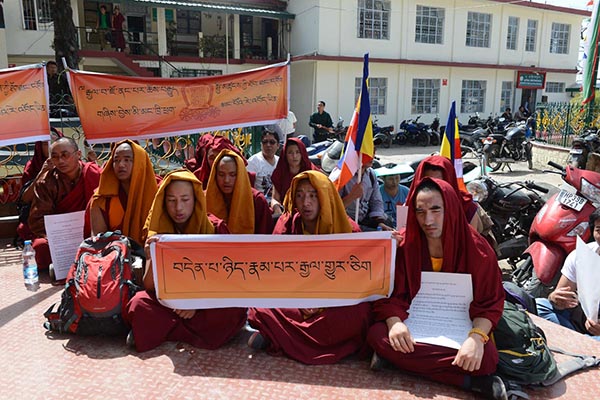
The Jonangpas protesting outside the Tibetan Parliament, to get equal representation. Separately, they also organized a hunger strike for this purpose.
Despite their recognition as a Buddhist sect, the Jonangpas do not have their representatives in the TPiE. To make matters worse, in 2015, the Tibetan Parliament voted against giving them equal representation. This vote led to the Jonangpas protesting in front of Parliament and going on a hunger strike against their own government. The fact that the TPiE voted against someone having equal representation is the clearest sign that the Tibetan leadership shuts down freedom of speech, and has absolutely no intention of building a government that serves the people.
TCV students being questioned
In 2014, the Sikyong Lobsang Sangay visited the TCV School in Dharamsala where he held a public forum with the students. A number of students stood up and politely questioned Lobsang Sangay on the validity of the Dorje Shugden ban. Visibly angered by their questioning, Sikyong Lobsang Sangay’s face immediately darkened and he refused to provide direct and clear answers.
Days later, it was revealed that not only had Lobsang Sangay failed to adequately answer their questions, but he had also arranged for them to be questioned. It transpired that the students were questioned about their reasons for asking about the Dorje Shugden ban. It seems Lobsang Sangay was unable to fathom why anyone, let alone children, would question the leadership. Compare this to, say, former President Barack Obama who took questions from all quarters of society and even educated his audience on the merits of freedom of speech if they tried to boo down any anti-Obama hecklers.
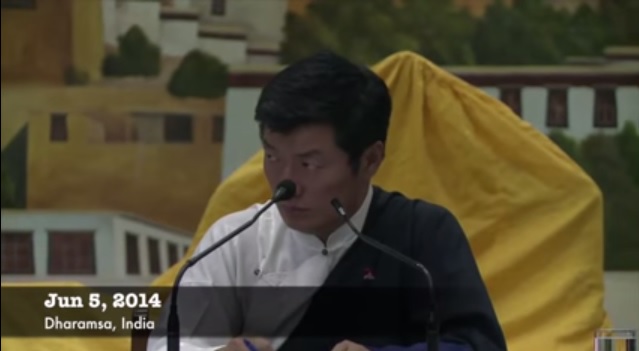
Can you imagine Barack Obama staring at someone like this when they dare to ask a question? Sikyong Lobsang Sangay was not happy when the youths questioned the Dorje Shugden ban.
In the Tibetan community however, intelligent, observant school-aged children who had the opportunity to address their leader were interrogated by the authorities simply for asking questions. The end result will surely be a generation of children who are too scared in the future to ask any questions of their leadership, no matter how benign their queries or intention. This entire incident can be interpreted in two ways – the Tibetan leadership can be intimidated by questions from school-going children, and the Tibetan leadership is not above threatening and intimidating children to shut down their freedom of speech.
Phukhang Khangtsen expels a monk
In December 2016, WeChat was abuzz with news that a monk from Gaden Shartse Monastery had been expelled for supposedly speaking out against the Dalai Lama. The incident took place after the Dalai Lama’s speech in Bodhgaya during the Kalachakra initiations. A Geshe of Phukhang Khangtsen in Gaden Shartse Monastery had been so upset with His Holiness’ remarks that he had recorded a series of audio messages critical of His Holiness’ comments. (For reasons of his safety, the Geshe will not be identified here as there are severe and often violent consequences for contradicting the Tibetan leadership.)
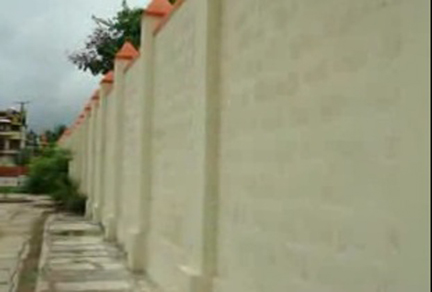
The wall in Gaden Shartse Monastery which separates the non-Shugden monks from the Dorje Shugden devotees in Shar Gaden Monastery. After the ban was first implemented in 1996, and was further enforced in 2008, the Shugden monks were expelled from Shartse and a wall was built to divide the monastery in two. It seems that in this day and age, Dharamsala has not yet finished with their campaign to expel monks.
In his audio, the Geshe said that the Dalai Lama told everyone that if you are a Shugden practitioner and you have even a Nyingma text, Dorje Shugden will harm you for this. The Geshe said that this is not logical and that Domo Geshe Rinpoche, for example, had a Guru Rinpoche statue. The meaning was, Domo Geshe Rinpoche had a statue and nothing happened to him so how is it logical that possessing a text would harm someone? The Geshe’s remarks were direct and not rude, but they were spoken with the air of someone who was very frustrated with a lot of pent-up energy that was all being let out now.
As ever, the consequence was swift. Rather unsurprisingly, the Tibetan leadership received a copy of this audio message and responded by sending a fax down to Gaden Shartse Monastery. The fax said that the monk was criticizing the Dalai Lama and it applied pressure on the monastery to expel him. After receiving the fax, the Phukhang Khangtsen administrators held a meeting with the Geshe. They asked him to go to Dharamsala to apologize for his remarks but he told them why should he, when he has not done anything wrong? He also asked them to think carefully. He said he did not mind apologizing but would the Tibetan leadership in Dharamsala really accept his apology if he were to go? He did not think so.
Ultimately, left with little choice, Phukhang Khangtsen expelled the monk although he had, as he said, done nothing wrong. He had only spoken to his mind and commented on the Dalai Lama’s remarks, but this had been severe enough to earn him an expulsion from the monastery. To this day, the Tibetan leadership continues to expel monks because their opinions do not match the leadership’s.
Conclusion
There is overwhelming evidence of the Tibetan leadership’s crimes against their own people, especially in the matter of freedom of speech. Within the Tibetan community, there is zero tolerance for speaking against or holding opinions that differ from the leadership’s. When anyone is caught doing so, no matter how small the infraction or how mundane the remarks, the Tibetan leadership’s heavy handed brand of so-called ‘justice’ is applied very quickly and violently.
It is precisely this intolerance for different ideas and opinions that has led the Tibetan leadership to the quagmire it finds itself in today. After 60 years of exile, so little has been achieved for the Tibetans socially, economically and politically because the leadership is deathly afraid of new ideas. By clamping down on freedom of speech, the leadership makes their people afraid to speak up and Dharamsala’s actions leave no room for innovative ideas and opinions from intelligent, educated and open-minded Tibetans. Everything that does not protect the old guard is thrown out, along with the people who dare to say it.
But by ignoring the opinions of thinkers like Jamyang Norbu or Lukar Jam, and by marginalizing them, the Tibetan leadership operates with their blinders on. Unable to see the world beyond their noses, they keep repeating the same mistakes over and over again while the world around them changes. The world today is not the world of 1959 when the Tibetans first entered exile; people today are more exposed, have access to more knowledge to make different choices, and have more opportunities to move away from things they do not like. They know more about the Tibetan leadership, community and cause than what the people of 1959 knew, meaning they have more information to decide if this is really where they want to their put money to.
So if the Tibetan leadership keeps this up, their community and their cause is doomed to failure. As their crimes are increasingly exposed, over time the leadership will find their support base dwindling until finally, there is none. No one wants to see their money being used to support and fund a group of despots who do everything they can to violate the fundamental human rights of their people.
Thus clamping down on freedom of speech, freedom of religion and freedom of expression is not how the Tibetan community will improve and grow. So while there is much hope that the Tibetan leadership will eventually realize this for their people’s welfare, after 60 years both time and hope are fast running out.
MORE NEWS LIKE THIS